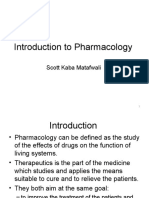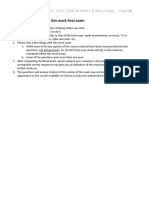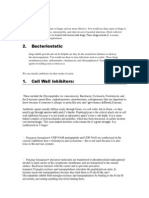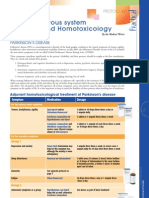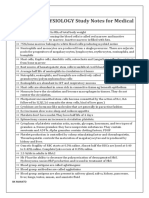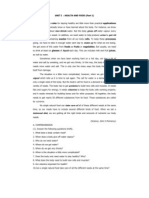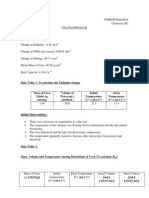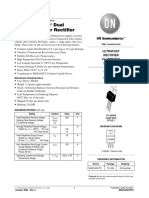Hess' Law Mgso4 Final
Hess' Law Mgso4 Final
Uploaded by
Atikah OlivaCopyright:
Available Formats
Hess' Law Mgso4 Final
Hess' Law Mgso4 Final
Uploaded by
Atikah OlivaCopyright
Available Formats
Share this document
Did you find this document useful?
Is this content inappropriate?
Copyright:
Available Formats
Hess' Law Mgso4 Final
Hess' Law Mgso4 Final
Uploaded by
Atikah OlivaCopyright:
Available Formats
Simon Johnson
Wednesday, 3 June 2009
Year 13 Chemistry Practical Hess Law Aim MgSO4 (s) + 7H2O (l) MgSO4 . 7H2O (s)
DCP, CE
Background anhydrous MgSO4 in water and hydrated MgSO4 . 7H2O in water, and Hesss Law. aq MgSO4 (s)
1
then use
MgSO4 (aq)
7H2
aq
MgSO4 . 7H2O (s)
Equipment
Plastic Coffee Mug Hydrated MgSO4.7H2O 100 mL Measuring Cylinder
Data Logger with Temperature Probe Anhydrous MgSO4 (in dessicator)
Method 1. Use the 100 mL measuring cylinder to measure 100.0 mL of water into a plastic coffee mug and record the temperature. 2. Accurately weigh about 7.5 g of anhydrous MgSO4. 3. Add this to the water and stir with the temperature probe. 4. Record the temperature change using the data logger. 5. Repeat the whole procedure using 15.5 g of hydrated MgSO4.7H2O Theoretical Enthalpy Change = -100 kJ mol-1 Enthalpy of Hydration for anhydrous magnesium sulfate = -84 kJ mol-1 Enthalpy of Hydration for hydrated magnesium sulfate = +16 kJ mol-1 (Experiments in Seventm Form Chemistry a Laboratory Manual. Dept Education New Zealand 1978) Data
of
Simon Johnson
Wednesday, 3 June 2009
A Data Table Showing the Relationship between Time Elapsed and the Temperature of the Reaction of both Hydrous and Anhydrous Magnesium Sulphate Time Sec, 0.05sec
0 0.5 1 1.5 2 2.5 3 3.5 4 4.5 5 5.5 6 6.5 7 7.5 8 8.5 9 9.5 10 10.5 11 11.5 12 12.5 13 13.5 14 14.5 15 15.5 16 16.5 17 17.5 18 18.5 19 19.5 20
Anhydrous MgSO4 Temperature C, 0.2C
13.30 13.30 13.30 13.27 13.20 13.15 13.10 13.00 12.95 12.87 12.80 12.75 12.67 12.59 12.54 12.47 12.39 12.34 12.27 12.27 12.29 12.29 12.34 12.34 12.34 12.32 12.29 12.32 12.37 12.44 12.49 12.54 12.57 12.62 12.72 12.77 12.80 12.80 12.85 12.87 12.90
Hydrated MgSO4 Temperature C, 0.2C
16.49 16.51 16.63 16.90 17.31 18.24 19.00 19.24 19.19 19.71 20.82 21.61 22.78 24.87 26.31 26.84 27.72 28.16 27.58 26.33 25.45 24.71 24.22 23.89 23.87 23.78 23.57 23.41 23.27 23.15 23.01 22.85 22.71 22.69 22.62 22.55 22.52 22.57 22.64 22.71 22.78
Change in Temperature =12.27-13.30 (0.2C + 0.2C) =-1.03 0.4C Initial Temperature, C, 0.2ml Initial Weight, g, 0.001g Initial Volume, ml, 0.5ml 13.30 7.500 100.
=28.16-16.49 =11.67
16.67 15.523 100.
Simon Johnson
Wednesday, 3 June 2009
Observations: There was no visible colour change in either reaction: the water remained colourless. In the anhydrous reaction, a white precipitate was formed. No precipitate was formed in the other reaction. Note that data has been rounded to 4 significant figures. Whilst the data was supplied by the data logger was to 8 significant figures, such a level of accuracy is futile, considering the random error on the thermometer is 0.2. 4 significant figures was therefore chosen for tabulation.
Calculations
The enthalpy change between MgSO4 (s) + 7H20 and MgSO4 . 7H2O (s) (hereafter H2), is impossible to determine directly. Hence an intermediate step must be applied according to the diagram below aq MgSO4 (s) MgSO4 (aq) H1
7H2O
H2
H3
aq
MgSO4 . 7H2O (s) For this calculation, H1 = H2 + H3 according to Hess law. As we can determine H1 and H3, we will be able to determine H2 by rearranging. Reaction One: hydrating Anhydrous MgSO4 For this, and the next calculation, it is required that we assume that the mass of one millimetre of water to be one gram. That is, that the density of water is 1 g/ml-1. I have therefore converted into kilograms below without further comment. H1 = mass of water x specific heat capacity x change in temperature = 0.1 x 4.18 x 11. 56
= 4.43. kJ = 0.5% + 3.46.% = 3.96..%
The next step is to determine the amount of moles that reacted.
Moles (MgSO4) = mass(MgSO4) / molar mass (MgSO4) Moles (MgSO4) = 7.500 / 120 =0.00625 =0.0133.%
From this, we can say that H1 = 4.43. kJ per 0.00625 mol
=-77.7 kJ per 1 mol
=3.96%+ 0.013% =3.977%
Note that we can say that it is exothermic due to the gain in temperature and hence has a negative state symbol.
Simon Johnson
Wednesday, 3 June 2009
Reaction Two: aquifying Hydrated MgSO4 H3 = mass of water x specific heat capacity x change in temperature = 0.1 x 4.18 x1.03
= 0.43054 kJ = 0.5% + 38.8% = 39.3%
The next step is to determine the amount of moles that reacted
Moles (MgSO4.7H20) Moles (MgSO4) = mass(MgSO4.7H20)) / molar mass (MgSO4.7H20)) = 15.523 / 246.51 =0.006mol =0.006.%
From this, we can say that H3 = 0.43. kJ per 0.006 mol
=+6.83 kJ per 1 mol
=39.3%+ 0.006% =39.3%
Note that we can say that it is endothermic due to the loss in temperature and hence has a positive state symbol. The next thing is to calculate the value of H2. Remembering that H2 + H3 = H1 and so, H1 - H3 = H2 H2 = H1 - H3 =-77.7 kJ - 6.83
=-84.5 kJ mol (3sf) 40kJ (1sf)
-1
=39.3% + 3.977% =43.2%
Percentage Deviation
The accepted literature value for reaction H2 is -100kJ mol-1. 1Accordingly, we can calculate the percentage deviation of our final answer: Further, given the literature value of H1 of -84 kJ mol-1 and an accepted literature value of of H3 of +16 kJ mol-1, we can calculate the percentage deviation of the other two reactions.2 H1 H3
Data Comparison
The final table shows a comparison of results, attained by individual groups. The methodology and execution of the experiment was essentially identical. Hence, this data can be used for a comment on the precision of this methodology in calculating the enthalpy change. Note that the random error will be identical, as the method was identical. H1 -55.0 -77.7 -54.3 -53.9 -54.2 H3 +8.07 +6.83 +7.29 +9.26 +5.30 H2 -63.1 -84.5 -61.5 -63.2 -64.3
1 2 3 4 5
1 2
Experiments in Seventh Form Chemistry- a Laboratory Manual. Dept of Education New Zealand, 1978 Both ibid.
Simon Johnson
Wednesday, 3 June 2009
Conclusion
The aim of this experiment was to determine experimentally the enthalpy change for the following reaction: MgSO4 (s) + 7H2O (l) MgSO4 . 7H2O (s) and hence to compare this to the literature value. As it is not possible to do this directly, Hess law was used to calculate the reaction indirectly. We were able to calculate the enthalpy change for this reaction to be -83.4kJ mol-1. This compared to a literature value of 100kJ mol-1, a percentage deviation of 15.5%. There are two conclusions that can be drawn from this: firstly, that this reaction is an exothermic reaction, secondly, that our experiment has problems and errors in it that caused the deviation from the literature value. How can this be explained scientifically? Breaking a bond is an endothermic reaction: it requires energy from the surroundings. Conversely, forming a bond is an exothermic reaction. The enthalpy change is the measure of this energy change, which is calculated by the mass of the substance multiplied by the specific heat capacity of the substance multiplied by the specific heat capacity of water. Here, a negative enthalpy change can explain the fact that the reaction which we are investigating is exothermic. Some comment is necessary on our data.. Our result was reasonably consistent with the literature value, giving a percentage deviation of 15.5%, but the total error was considerable: 43.2%. This suggests that the methodology should be reviewed to reduce the total percentage error to ensure a result closer to the literature value. The other comment is required on the precision of the data. This experiment, owing to logistical problems, could not be repeated several times. Instead, the values can be compared to other groups who undertook experiments under identical conditions. In theory, these results should be the same. As can be seen from the final table above, the results are reasonably precise, 4 of the 5 groups achieved roughly similar results. The differences in this can be explained by random error in this experiment: a considerable source of error for our results. A change in the experiment should initially concentrate on reducing the random error, a factor that was considerably more important to this experiment than the systematic error of the experiment.
Evaluation
There were two principle sources of error in this experiment: random error that was carried through by error propagation and from systemic error, most notably due to heat loss. One key source of systemic error was the heat lost in this experiment. The experiment was conducted using a plastic coffee mug. This is considerably more insulated than other forms of container that have been used. However, it is not perfect and some heat will have been lost, most noticeably through the process of opening and closing the beakers lid, and through the stirring rod. This would have been seen in the final result: if the reaction in H 3 had lost less heat, the change in temperature would have been greater, and hence the enthalpy change would have been bigger. This would equally apply to H2 . Such a problem is impractical to attempt to deal with under experimental conditions. An insulated beaker is as insulated as is practically possible. The process becomes one of control. If we undertook the experiment in an object of known heat capacity, we would be able to calculate the energy lost. This could be added to the enthalpy change already calculated, giving a more accurate result. The other key aspect of systemic error is the problem in stirring. This was a key aspect of the methodology: by stirring the reaction, we ensured that the reaction reacted faster. This had the effect of reducing the duration of the reaction, and hence the amount of heat lost to the surroundings. This had a noticeable effect on the data in a similar vein to as been already described: if reaction H2 had lost less heat to the surroundings, the change in temperature would have been greater, and hence the enthalpy change bigger overall. This would especially help to explain the disparities between each group. Stirring is a subjective descriptor, and one group could have stirred much more vigorously than the other. This would have had the effect described previously of decreasing the final enthalpy change.
Simon Johnson
Wednesday, 3 June 2009
Fortunately, this can easily be rectified. The process of stirring can be replaced by a magnetic stirrer. If this was done, the magnet would stir the solution an equal amount of times in every experiment. This would help to create a much more precise set of results for our data. The key cause of random error can be seen clearly in this experiment. In order to calculate the total error percentage, the percentage error of each step of the reaction was required. The percentage error of the change in temperature was 0.4C. Such a value is reasonably low. However, it can generate a very high percentage error when small raw numbers are used. The calculation of the percentage error of the change in temperature in H 3 produced such an error. Because the raw value is so low, the percentage error was considerable at nearly 40% and was then propagated throughout the experiment. The effect of this was to artificially increase the random error in the experiment considerably. A solution is very hard to determine for this. The experiment requires the change in temperature value determined, and error propagation requires a percentage error. The most effective solution is to suggest that this problem casts doubts upon the usefulness of the total percentage error, and that it should be used with other methods of statistical analysis, for example, percentage deviation and the precision of the results, when we assess the accuracy of the experiment. A comment on the equipment used is important. For this experiment, we used a measuring cylinder, scales and a data probe to gain our results. The scales and data probe have a very low percentage error on them naturally. The measuring cylinder has a much greater one. The random error on a measuring cylinder is 0.5ml. This is a reasonably large error, and will have the effect of increasing the total percentage error considerably. Because of this, the confidence that we can have in our final answer is decreased. Again, a simple step can be taken to reduce the percentage error in this respect. There is no reason that a measuring cylinder has to be used. The water could be measured using a pipette which has a significantly lower percentage error. However, as a pipette can only hold 25ml, four pipettes would be required; quadrupling the percentage error. More effectively the water could be weighed. Assuming that one millilitre of water weighs one gram, the gravimetrical scales could be effectively used to reduce the extent of the error. The scales have a much lower random error, and so we would reduce the total percentage error significantly. Whilst the assumption that one millimetre of water weighs a gram requires standard temperature and conditions for the density to remain accurate, that should not be a practical problem for our experiment. One key error came in this experiment during the calculation of individual enthalpy changes. For both H 1 and H3 the literature value was greater than the value which we found. This can be explained by a key assumption. We assumed in the process of calculation that the mass of the water reacting was 0.1kJ. This is correct; however, it does not take into account the fact that both masses were greater than 0.1kJ when the reacting MgSO4 is added. Both of the enthalpy values were smaller than expected because of this problem: had it been included, the enthalpy changes would have been greater. The percentage deviation in H3 was greater than the percentage deviation for H1 because of the difference in masses. The mass of MgSO4 in H3 was double that of H1. This helps to explain the greater percentage deviation: the greater mass in H3 had a greater effect on the enthalpy change than the smaller mass in H1. The solution to this is reasonably simple. Instead of assuming 0.1kJ of water, we could use the combined weights of water and the MgSO4. This could be done without further work: the weight of the MgSO4 is already gained in the experiment to calculate the moles. Whilst this would increase the total percentage error slightly, such a drawback would be worth it for the benefit to the experiment of a much more accurate set of enthalpy changes. However, one further error came during the process of calculation. We assumed the specific heat capacity of the solution to be 4.18 kJ, the same to that of distilled water. There are two errors in this assumption: firstly that the water was distilled when it wasnt. The specific heat capacity of impure water is greater than that of distilled water. As we used impure water but the heat capacity of distilled water, a smaller enthalpy change than expected was gained. To solve the problem of impure water is simple. The method should be simply changed to the use of distilled water; making the specific heat accurate and meaning that the enthalpy change is more consistent with the literature value.
You might also like
- Full Download Rang & Dale's Pharmacology 9th Edition Various Authors PDFDocument64 pagesFull Download Rang & Dale's Pharmacology 9th Edition Various Authors PDFsininbagdi8075% (4)
- Electrical Installation Design Guide PDFDocument15 pagesElectrical Installation Design Guide PDFJack So0% (3)
- Avrahova - Engl For Pharmacists - 2vDocument10 pagesAvrahova - Engl For Pharmacists - 2vDians0% (1)
- Health Psychology: An Introduction To Behavior and HealthDocument2 pagesHealth Psychology: An Introduction To Behavior and HealthCarolina ReyesNo ratings yet
- KetoprofenDocument22 pagesKetoprofenRickNo ratings yet
- Zhanguo, Jiuru - Simultaneous and Direct Determination of Oxalic Acid, Tartaric Acid, Malic Acid, Vitamin C, Citric Acid, And Succinic Acid in Fructus Mume by Reversed-phase High-performance Liquid Chromatography. - 2002Document5 pagesZhanguo, Jiuru - Simultaneous and Direct Determination of Oxalic Acid, Tartaric Acid, Malic Acid, Vitamin C, Citric Acid, And Succinic Acid in Fructus Mume by Reversed-phase High-performance Liquid Chromatography. - 2002splash_7678No ratings yet
- Introduction - To - Pharmacology PowerPointDocument16 pagesIntroduction - To - Pharmacology PowerPointAngetile KasangaNo ratings yet
- Instrumental Methods For The Analysis and Identification of Bioactive MoleculesDocument370 pagesInstrumental Methods For The Analysis and Identification of Bioactive MoleculesSuyog patilNo ratings yet
- Medical TerminologyDocument11 pagesMedical TerminologyadadanNo ratings yet
- Experiment 14Document7 pagesExperiment 14Jc GohNo ratings yet
- Unit Plan. P1. MotionDocument2 pagesUnit Plan. P1. MotionSuta PinatihNo ratings yet
- Silo - Tips - Chapter 5 The Gaseous StateDocument18 pagesSilo - Tips - Chapter 5 The Gaseous StateJerich Ivan PaalisboNo ratings yet
- الادوية (ملزمة) PDFDocument49 pagesالادوية (ملزمة) PDFdhyaa100% (1)
- Principles of Drug ActionDocument42 pagesPrinciples of Drug ActionkjghlkdfjgNo ratings yet
- Unit 3 - Cell Energy Guided NotesDocument3 pagesUnit 3 - Cell Energy Guided NotesKaylee Lopez Student - KnightdaleHSNo ratings yet
- The Healing Power of Chinese Herbs and Medicinal Recipes (PDFDrive)Document1,122 pagesThe Healing Power of Chinese Herbs and Medicinal Recipes (PDFDrive)KuntoNo ratings yet
- English For Pharmacy Writing and Oral CommunicationDocument1 pageEnglish For Pharmacy Writing and Oral CommunicationhutamiNo ratings yet
- Introduction To PHARMACOLOGYDocument85 pagesIntroduction To PHARMACOLOGYferhanmu419No ratings yet
- Mock Final ExamDocument15 pagesMock Final ExamAryan PatelNo ratings yet
- Blood: TransportationDocument29 pagesBlood: TransportationShobhit GajbhiyeNo ratings yet
- Compendium of Pharmaceuticals and Specialties PDFDocument2 pagesCompendium of Pharmaceuticals and Specialties PDFJainner ContrerasNo ratings yet
- Pharmacotherapy For GERDDocument6 pagesPharmacotherapy For GERDJoon HyungNo ratings yet
- BactericidalDocument15 pagesBactericidalAbdallah OmerNo ratings yet
- Effects of Zinc Supplementation On Serum Lipids A Systematic Review and Meta-AnalysisDocument16 pagesEffects of Zinc Supplementation On Serum Lipids A Systematic Review and Meta-Analysispronto4meNo ratings yet
- Insulin 08Document99 pagesInsulin 08Archana Govindan100% (1)
- 1a73 PDFDocument3 pages1a73 PDFDr. KaarthikaNo ratings yet
- Analgesics: L. SchefflerDocument32 pagesAnalgesics: L. SchefflerNovita_PemalangNo ratings yet
- Chapter 021Document8 pagesChapter 021api-281340024100% (1)
- Oml This Is A Lifesaver BruhDocument9 pagesOml This Is A Lifesaver BruhGeneralBrainsNo ratings yet
- Central Ner Vous System Disorders and Homotoxicology: Parkinson'S DiseaseDocument3 pagesCentral Ner Vous System Disorders and Homotoxicology: Parkinson'S DiseaseRui PiresNo ratings yet
- Clinical Pharmacology in Healthcare, Teaching and ResearchDocument80 pagesClinical Pharmacology in Healthcare, Teaching and ResearchVNcomer100% (2)
- List of Clinical Medicine Books: Titles Authors Publisher YearDocument13 pagesList of Clinical Medicine Books: Titles Authors Publisher Yearwaqas_xsNo ratings yet
- Blood Test Reference Range Chart Test Reference Range (Conventional Units )Document3 pagesBlood Test Reference Range Chart Test Reference Range (Conventional Units )QaSeh ISnaNo ratings yet
- Tsi Test ContentDocument3 pagesTsi Test Contentapi-305517815No ratings yet
- 100 ThoughtsDocument3 pages100 Thoughtsraju_pnNo ratings yet
- Medical Terminology PDFDocument20 pagesMedical Terminology PDFjebashanthini100% (1)
- Tues 8-00 Parkinson's Disease - The BasicsDocument44 pagesTues 8-00 Parkinson's Disease - The BasicsuntungNo ratings yet
- Observation Skill - Dr. Zhijiang Chen - S Chinese Herbal Remedies Series - Book Contains Eye-Ology, Nail Observation, and Tongue Observation Skills.Document170 pagesObservation Skill - Dr. Zhijiang Chen - S Chinese Herbal Remedies Series - Book Contains Eye-Ology, Nail Observation, and Tongue Observation Skills.Santé QuantiqueNo ratings yet
- PosologyDocument23 pagesPosologyDhachina MoorthiNo ratings yet
- Histology Structure of SkinDocument4 pagesHistology Structure of SkinLIEBERKHUNNo ratings yet
- The Gonadal Hormones & InhibitorsDocument41 pagesThe Gonadal Hormones & InhibitorsSaddamix AL Omari100% (1)
- Costipation CorrectionDocument21 pagesCostipation CorrectionTim CostaNo ratings yet
- Diams PharmacologyDocument190 pagesDiams PharmacologyShruthi KyNo ratings yet
- Plan For Today: Finish Up With Electron Transport Chain and Oxidative PhosphorylationDocument52 pagesPlan For Today: Finish Up With Electron Transport Chain and Oxidative PhosphorylationKalai KrishnamurthyNo ratings yet
- Master Pharm Drug ListDocument1 pageMaster Pharm Drug ListMichelle StramNo ratings yet
- Blood Test RangesDocument18 pagesBlood Test Rangeskltran80No ratings yet
- Please Don't Replicate This MaterialDocument1 pagePlease Don't Replicate This MaterialOmar Christian TuazonNo ratings yet
- Pediatrics Workbook 2020Document11 pagesPediatrics Workbook 202019212024 AzizahNo ratings yet
- Body Systems Interactions ChartDocument5 pagesBody Systems Interactions Chartapi-293216402100% (1)
- Insomnia PowerpointDocument16 pagesInsomnia Powerpointapi-255944865No ratings yet
- Protein Digestion Absorption NASPGHANDocument4 pagesProtein Digestion Absorption NASPGHANDahiru Muhammad100% (1)
- Spectrum of Tardive Syndromes: Clinical Recognition and ManagementDocument11 pagesSpectrum of Tardive Syndromes: Clinical Recognition and ManagementDan SamNo ratings yet
- Anatomy & Physiology Terms DECODED! Vol.3A: Muscular System: Gross AnatomyFrom EverandAnatomy & Physiology Terms DECODED! Vol.3A: Muscular System: Gross AnatomyNo ratings yet
- Ginkgo Biloba - Mother Tincture - ABC Homeopathy ForumDocument2 pagesGinkgo Biloba - Mother Tincture - ABC Homeopathy Forumcet.ranchi7024100% (1)
- Dilutions Principles and ApplicationsDocument3 pagesDilutions Principles and ApplicationsnavinchellaNo ratings yet
- 6 Chapter3sterileandnonsterilecompounding 150727065209 Lva1 App6892Document36 pages6 Chapter3sterileandnonsterilecompounding 150727065209 Lva1 App6892Lina TasamaNo ratings yet
- BLOOD PHYSIOLOGY Study Notes For Medical StudentsDocument3 pagesBLOOD PHYSIOLOGY Study Notes For Medical StudentsBijay Kumar MahatoNo ratings yet
- Hisstory of PharmacyDocument31 pagesHisstory of PharmacyIka Widiawati100% (1)
- English For PharmacistDocument38 pagesEnglish For PharmacistIpank Ezeguel-Cyber100% (2)
- HEALTH - So Many AspectsDocument24 pagesHEALTH - So Many AspectszoeNo ratings yet
- Entropy LabDocument6 pagesEntropy LabSiddharth RajendranNo ratings yet
- Motor Specification Sheet: SS-N-3128-ADocument2 pagesMotor Specification Sheet: SS-N-3128-AKong MaprasertNo ratings yet
- Full-Load Testing of Large Gearbox Using Close-Loop Criculation PowerDocument4 pagesFull-Load Testing of Large Gearbox Using Close-Loop Criculation PowersurawutwijarnNo ratings yet
- UG Basic Electrical Engineering EnglishDocument35 pagesUG Basic Electrical Engineering Englishvinoth18No ratings yet
- Experiment No 6 Rolling Disc On Inclined Plane Objective: ApparatusDocument5 pagesExperiment No 6 Rolling Disc On Inclined Plane Objective: ApparatusAliNo ratings yet
- Sustainability 15 10554 v2Document25 pagesSustainability 15 10554 v2Oussama ElyoussfiNo ratings yet
- 2-Power Flow AnalysisDocument56 pages2-Power Flow AnalysisFady MichealNo ratings yet
- Chapter 1Document38 pagesChapter 1tilahun yeshiyeNo ratings yet
- Overall Ac SLD - SattaurDocument1 pageOverall Ac SLD - SattaurSumit TyagiNo ratings yet
- Lesson 1 Exercises Problem No. 2Document2 pagesLesson 1 Exercises Problem No. 2Ariel Gamboa100% (1)
- Handouts PPE Day 1Document7 pagesHandouts PPE Day 1Juan T AmadNo ratings yet
- Lect 6 Extra Examples PDFDocument5 pagesLect 6 Extra Examples PDFZaidoon MohsinNo ratings yet
- Report For Experiment #5 Uniform Circular Motion: Noah Hamlen Lab Partner: Martin Caruso TA: James Grammatikos 2/7/2016Document6 pagesReport For Experiment #5 Uniform Circular Motion: Noah Hamlen Lab Partner: Martin Caruso TA: James Grammatikos 2/7/2016api-353845194No ratings yet
- PLTW Engineering Formula Sheet 2018 (v18.0) : StatisticsDocument11 pagesPLTW Engineering Formula Sheet 2018 (v18.0) : StatisticsCarlyn DansieNo ratings yet
- Vijjeswaram Power Plant VisitDocument3 pagesVijjeswaram Power Plant VisitVenkatesh KumarNo ratings yet
- 1.5hp 2p XP Us MotorsDocument13 pages1.5hp 2p XP Us MotorsOswaldo Romario Fernandez CuevaNo ratings yet
- On Semiconductor MUR1620CTR DatasheetDocument4 pagesOn Semiconductor MUR1620CTR Datasheetalexnder gallegoNo ratings yet
- DIRD 02-DIRD Aerospace Applications of Programmable Matter PDFDocument21 pagesDIRD 02-DIRD Aerospace Applications of Programmable Matter PDFypie01No ratings yet
- Solved - A 2.1-M-Long, 0.2-Cm-Diameter Electrical Wire Extends A...Document3 pagesSolved - A 2.1-M-Long, 0.2-Cm-Diameter Electrical Wire Extends A...johan razakNo ratings yet
- Soalan Latihan Matematik 21-40 Edisi 3Document9 pagesSoalan Latihan Matematik 21-40 Edisi 3Jayashri SelvendranNo ratings yet
- Three Phase Fault Detection System in Transmission Line Using ArduinoDocument10 pagesThree Phase Fault Detection System in Transmission Line Using ArduinoKusha Satapathy100% (1)
- CPC Cooperative Patent ClassificationDocument11 pagesCPC Cooperative Patent Classificationneeraj12121No ratings yet
- P Tran Solution 1Document37 pagesP Tran Solution 1MiguelaTayNo ratings yet
- IEEE STD C62.34™-2017 Standard For Test MethodsDocument40 pagesIEEE STD C62.34™-2017 Standard For Test MethodsMarcelo VillarNo ratings yet
- Chapter 5 - CavitationDocument44 pagesChapter 5 - CavitationSiraj MohammedNo ratings yet
- Magnetic Effects Class 10Document6 pagesMagnetic Effects Class 10Lokesh VaswaniNo ratings yet
- BOG - ElDoradoIntl - Colombia (WMO 802220) 2017Document2 pagesBOG - ElDoradoIntl - Colombia (WMO 802220) 2017Ricardo RochaNo ratings yet
- Numerical Modelling Formula 1 Vehicle Resistive Forces in Scilab-Xcos Practice Blocks & Acquaint To Use GUI of Scilab-XcosDocument4 pagesNumerical Modelling Formula 1 Vehicle Resistive Forces in Scilab-Xcos Practice Blocks & Acquaint To Use GUI of Scilab-XcosPRAJWAL S 19BBTME007No ratings yet
- XH SCT T36Document7 pagesXH SCT T36Jyoti ShresthaNo ratings yet






